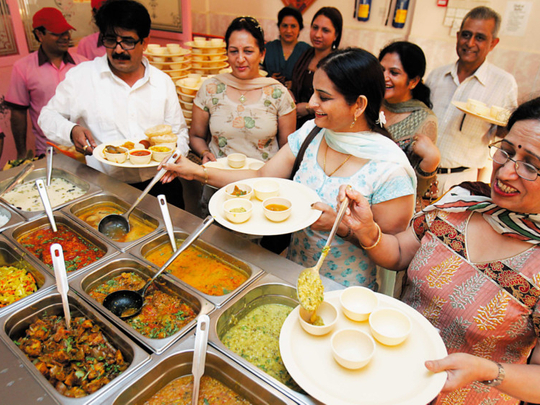
The buffet meal scene may resemble the siege of the Bastille. Somehow, ordinarily sensible people fear that the food will be taken away before they get some, or that others will take all of the choice items, leaving them to munch on radishes.
This irrational approach results in the two major buffet blunders: approaching the table too quickly and putting too much food on your plate.
Approach
Never sample the food before the buffet is officially open.
Just because cold platters are there before the hot dishes are set out does not signal a call to action, and it creates undue stress on the serving staff.
Before piling food on your plate, look at the dining tables.
If utensils are already there, you don’t need to look for them at the buffet table.
Remember, if place cards are set out on the table, do not shift them around to suit yourself.
Look to see whether the buffet has one or two lines.
Gender and status privileges do not apply in the buffet line. Don’t try to get ahead of anyone, and don’t break up a couple or a group going through the line together.
Dishing
If one item is in short supply, go easy on it. At a restaurant or hotel, it is fine to ask to have a dish replenished. At a private party, don’t ask.
Use the serving spoon or fork provided for a particular dish, and put the serving piece next to the platter or chafing dish when you are finished. A hot metal spoon in a chafing dish could burn the fingers of another diner.
Never overload your dish. Going back for seconds or thirds is perfectly acceptable. Don’t take platefuls of food for others at your table. That defeats the whole idea of a buffet, which is offering a multitude of choices for a variety of tastes and appetites.
Serving stations
When various dishes are served at serving stations, as at a brunch buffet, remember that the attendants are limited in what they can provide. Special requests are okay, as long as they are easily accomplished. And only ask for added ingredients that are in sight and readily available.
Plates
In a restaurant, plenty of clean, freshly polished plates should be available, which means you should not have to reuse a plate. When you’re going back to the buffet for seconds, don’t hesitate to ask a server to replace a plate or silverware, or retrieve what you need at the buffet table.
In a private home, use common sense to determine whether you should retain your plate or ask for a new one. In any case, never scrape and stack your plates when you’re finished.
Sitting down
If people invite you to join their table as you leave the buffet line, either accept graciously or find a way to decline just as graciously.
Even though people at your table will be sitting down to eat at different times, it’s still a good idea to keep pace generally with others at the table, while engaging them in conversation. If you need to leave the table temporarily, be sure to place your napkin on the seat or arm of your chair.
Napkins should not go back on the table until you are leaving for good.
Standing up
If you’re eating while standing up, at a stand-up buffet or a cocktail party, it’s even more important to avoid overloading your plate. That way you can circulate a bit. Keep your food in your left hand so that your right is available for handshakes.
You put yourself at a great disadvantage if both hands are occupied with food and drink.
When you settle on a place to stand, make sure you are not blocking the door or a path to the buffet table. But remember that social meals are seldom about the food itself, so mix and mingle.









